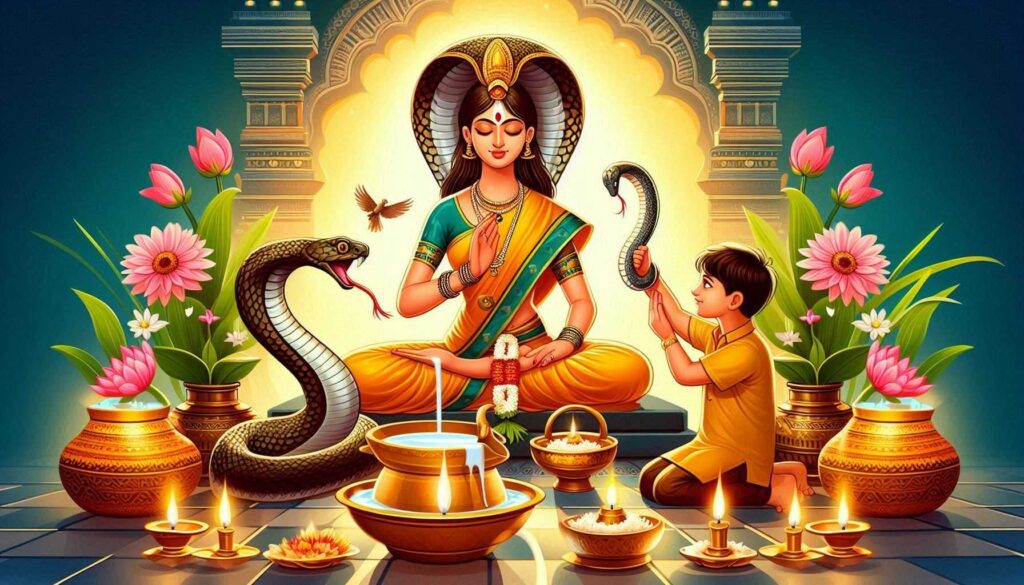Introduction

Naga Panchami a revered Hindu festival, celebrates the worship of serpents or “Nagas.” Traditionally observed on the fifth day of the Shukla Paksha (waxing phase of the moon) in the month of Shravan (July-August), this festival holds significant spiritual and cultural importance in various parts of India. This article delves into the meaning, rituals, significance, and regional variations of Naga Panchami, offering a comprehensive understanding of this age-old tradition.
Read More About Hindu Philosophy
Historical Significance of Naga Panchami

Nagas have been integral to Hindu mythology and culture for centuries. They are often associated with water bodies, fertility, and protection. In texts such as the Puranas, Nagas are depicted as powerful deities with a dual nature—both protective and destructive. Naga Panchami serves as a reminder of the reverence and respect Hindus have for these serpentine beings.
Connection with Mythology
The roots of Naga Panchami can be traced back to various myths and legends. One of the prominent stories involves the Naga king, Vasuki, who played a crucial role during the churning of the ocean (Samudra Manthan). Vasuki was used as a rope to churn the ocean, which led to the emergence of valuable treasures, including the nectar of immortality.
This connection illustrates the dual aspect of Nagas—protectors of treasures and harbingers of life. The festival thus becomes a means to pay homage to these mythological beings.
Rituals and Practices of Naga Panchami

The rituals associated with Naga Panchami vary widely across different regions of India, but certain elements remain consistent.
Common Rituals
- Naga Idols and Pictures: Devotees place images or idols of serpents in their homes or temples. Offerings of milk, rice, and flowers are made to these idols.
- Bathing and Purification: Many people take a holy dip in rivers or water bodies to purify themselves before performing the rituals.
- Fast and Prayers: Devotees often observe a fast, abstaining from grains and consuming fruits or milk. They recite prayers and hymns dedicated to Nagas, such as the “Naga Stotra.”
- Creating Naga Murtis: In some regions, clay or rice murtis (idols) of snakes are made and worshipped before being released into water bodies.
- Offerings to Ancestors: Naga Panchami is also a time for performing Tarpan (offering to ancestors), as it is believed that Nagas are the protectors of lineage.
Regional Variations
- Maharashtra: In Maharashtra, devotees create clay idols of snakes, offer milk, and perform rituals near rivers or ponds. Some people also visit temples dedicated to serpent deities.
- Karnataka: In rural areas, the festival is celebrated with traditional folk songs and dances, emphasizing community participation. The day is marked by visiting temples and performing rituals for ancestral Nagas.
- Kerala: The festival is associated with the worship of Nagas in the context of ancestral veneration. People offer rice and other food items to the serpents and engage in family gatherings.
- North India: In regions like Uttar Pradesh, Naga Panchami is celebrated with fervor, with devotees visiting temples dedicated to serpent gods and offering milk and sweets.
The Spiritual Importance of Naga Panchami
Naga Panchami transcends mere rituals; it serves as a means of fostering a deeper connection with nature and acknowledging the role of serpents in the ecosystem. The festival embodies several spiritual themes:
- Respect for Nature: By worshipping Nagas, devotees express gratitude and reverence for the ecological balance and the importance of water bodies.
- Ancestral Worship: The act of performing Tarpan on this day symbolizes respect for ancestors, acknowledging their contributions to one’s lineage.
- Seeking Protection: Many believe that worshipping Nagas brings protection from diseases, misfortunes, and negative energies, highlighting the protective aspect of these deities.
- Fertility and Prosperity: The connection between Nagas and fertility is profound; many women pray for healthy offspring and prosperity during this time.
Conclusion
Naga Panchami, with its rich history and diverse rituals, reflects the deep-seated beliefs and cultural practices of Hinduism. By recognizing the significance of serpents, this festival fosters an appreciation for the interconnectedness of life, nature, and the spiritual realm. As we celebrate Naga Panchami, we are reminded of our responsibilities toward nature and our ancestors, emphasizing the importance of tradition in our modern lives.
References for Image Creation
- Image of Naga Worship: Depict devotees offering milk and flowers to a clay idol of a snake, with traditional decorations in the background.
- Regional Celebrations: Illustrate a vibrant scene from Maharashtra or Karnataka, showing people in traditional attire participating in folk dances and rituals.
- Naga Murtis: Create an image of clay murtis of snakes being crafted and decorated by devotees.
- Sacred Water Bodies: Show a serene river or pond where people gather to perform rituals, symbolizing the connection with nature.


